HOME > Corporate Profile > Environmental Activities > Low Carbon > Our Approaches for Low Carbon
Our Approaches for Low Carbon
 Approach in Development and Design of Products
Approach in Development and Design of Products Approach in Procurement
Approach in Procurement Approach in Manufacturing
Approach in Manufacturing Approach in Sales and Logistics
Approach in Sales and Logistics Approach in Offices
Approach in Offices Others: Approach in Works
Others: Approach in Works
Approach in Development and Design of Products
Policy on Research & Development
RISO's development and design philosophy is to "Create Unique Products." Over the years, RISO has developed a wide range of products that provide advanced print solutions based on its unique print technology, as typified by the RISOGRPAH System. In addition, RISO is aggressively undertaking R&D activities in new fields, including inkjet technology. Inkjet technology has been applied in the Company's new line of high-speed color inkjet printers, the ComColor series. Such an aggressive R&D stance has produced tangible results, enabling RISO to develop the latest RISO MF and SF series digital duplicators with a design that reduces the product's environmental burden, as well as other environment-friendly products, such as RISO RICEINK.
Process for Implementing Environmental Considerations into Products
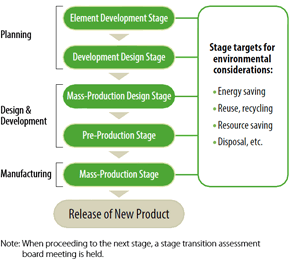
RISO assigns five stages -- from element development to mass production.
In each of these five stages, RISO sets targets for such items as environmental considerations, product quality, costs and schedule. By monitoring the progress of these targets, we make decisions on whether we can proceed to the next stage.
Stage targets for environmental considerations include energy and resource saving, reuse, recycling and disposal.
Compliance with the ErP Directive
The EU ErP Directive establishes a framework for the setting of ecodesign requirements for energy-related products known as ErP. Manufacturers of energy-related products under the scheme are obliged to reduce the energy consumption at the design stage. Product information based on the requirement of COMMISSION REGULATION (EU) 826/2023:Erp Lot6/26 is as follows.
Achieving a Low - Carbon Society through the Development of Environmentally Friendly Products
We contribute to a low-carbon society by developing innovative products such as energy-saving, resource-saving, recyclable, and other environmentally friendly products, and having them widely available for customers. We also deliver our products in recyclable packaging materials, and adopt joint delivery and modal shifts, considering the environment.
Low environmental burden with high productivity
The environment was a major consideration when RISO developed the ComColor printers and RISO digital duplicators.
ComColor, Environmentally friendly and User friendly
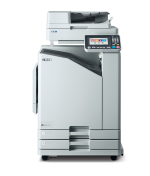
>Environmental Performance of ORPHIS
ORPHIS is an environmentally friendly high-speed color printer. In addition to its overwhelming printing speed, it has excellent durability, making high-volume printing operations more efficient. An inkjet method eliminates the need for a heater, which is necessary for thermally fixing toner, to reduce maximum power consumption.
*The ORPHIS FTseries is a brand for RISO full-color high-speed inkjet printers in Japanese domestic market.
Development of Environmentally Friendly Consumables
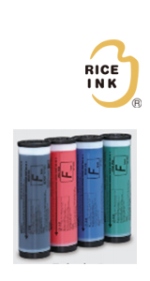
RISO is adopting vegetable-based ink which is made from rice bran oil. RISO was the world's first to develop and commercialize rice bran oil ink for digital duplicator.
Rice bran oil ink
The rice bran oil ink contributes to environment sustainability. Rice bran, which would be otherwise wasted, is a raw material with no VOCs, so after the oil is extracted for the ink. It can subsequently be used as fertilizer or animal feed.
Streamline recycling
In Japan, RISO collects and recycles used ink bottles. They are recycled and processed into plastic raw material.
Approach in Procurement
To provide environment-conscious products, RISO KAGAKU CORPORATION continues the effort to procure less environmental loading materials and components.
Green Procurement
RISO has been pursuing green procurement systems to provide environment-friendly products.
To lessen the environmental burden, environmental considerations must also be applied to the components and materials of the products.
To cope with such requirements, RISO has specified its principles and standards in the "Riso Kagaku Group Green Procurement Standard." In accordance with this standard, RISO requests that suppliers not only apply environmental considerations to the components and materials they deliver, but also establish an environmental management system. They are requested to acquire certification of their EMS, such as ISO 14001 or Eco-Stage, so that the proper control is maintained and enhanced.
Riso Kagaku Group Green Procurement Standard (main points)
- Positive attitude for improvement of environmental protection.
- Observation of applicable environmental regulations and laws.
- Elimination of materials prohibited by the company standard from the production process and from the material procurement operations.
Approach in Manufacturing
For the purpose of "Prevention of Global Warming" and "Effective Utilities of Resources", RISO promotes several activities, which include energy-saving or reduction of excretory products.
Approach to Energy Saving
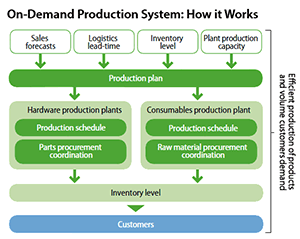
Adhering to the concept of manufacturing products in demand in a timely manner and in required volume, RISO's production departments engage in lean manufacturing operations that effectively use resources and energy.
Also, RISO avoids introducing high-volume, high-speed production facilities at the same time. Instead, when necessary, the Company introduces facilities in a stepwise manner to respond to the exact demand level while developing in-house facilities as much as possible based on its know-how and expertise.
Approach in Sales and Logistics
RISO KAGAKU CORPORATION attempts the reduction of CO2 emission or wastes, through switching to the transportation means of lower environmental loads, i.e., modal shifts and employment of reusable packing materials.
Modal Shift
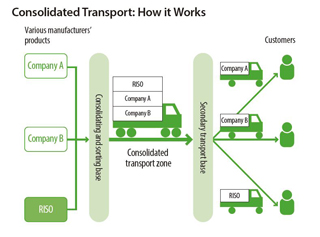
RISO started the modal shift where conventional transportation by trucks or airplanes has been switched to mass transportation means, such as railway or marine transport, because these are more environment-friendly.
*Modal Shift
It generally indicates the change of means of transport; it specifically implies shift from trucks or airplanes transportation to rails or sea transportation to reduce of green house gases or nitrogen oxides to the environment.
RISO and Cleanup Co., Ltd. together started the implementation of a consolidated transport strategy based on the Strategic Logistics Information Model (SLIM)* in October 2003. This joint initiative has contributed to improved transport efficiency, effectively reducing fuel consumption per unit of freight transportation (tkm).
*SLIM (Strategic Logistics Information Model):
Based on this model, the Strategic Logistics Partners (SLP) Community Information Center centrally manages delivery and other information collected from corporate clients to improve the full load ratio and the operational efficiency of logistics operations in general. Corporate clients can check delivery time, shipment weight and volume and other information via the Internet. (Source: Cargo News No. 3071)
Milk run system
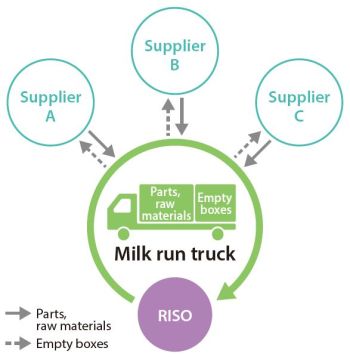
In Japan and at our overseas plants, we have switched from having each supplier deliver materials and parts to RISO plants to a system called Milk Run System in which a RISO truck goes around to multiple suppliers to pick up or deliver these supplies. This system not only improves loading efficiency but also reduces transport costs. In addition, it reduces the amount of CO2 emissions from delivery trucks, and thus reduces environmental impact.
Approach in Offices
RISO KAGAKU CORPORATION also promotes various environment-friendly activities in offices, such as sales branches or service stations, in order to support to reduce its load.
Activities in Offices to Reduce the Environment Load
RISO runs forty more sales branches all over Japan, which consume energy such as electricity or gas, as well as water. The consumption when compared with our manufacturing activity is much less. However, RISO assigns the majority of our human resources to such offices and recognizes the importance of environmental educations for operation of environmentally friendly business to them. Such action includes reduction of wastes by classified reuse, reduction of papers by new business style, or green purchase practices.
Others: Approach in Works
Creating a Low-Carbon Society by Supporting Environmental Education and Making Green Curtains
In connection with our products and business, we support environmental education for the community regarding energy-saving, resource-saving, and recycling to build a sustainable society. We also work to raise environmental awareness not only among our employees but also in the local communities, such as by installing green curtains at Works.
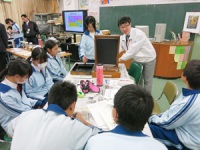
We support environmental education for the community on environmentally friendly printing by letting them experience printing using digital printers or mimeographs.
Green Curtain at Ube Plant Wins Award
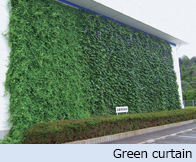
As part of everyday methods toward conserving energy and helping to prevent global warming we cultivate a green curtain at the Ube Plant. The curtain consists of bitter gourd and morning glory vines. The 15m wide by 6.5m tall curtain, which covers the entire south wall of the administrative building up to the second floor, received an award for excellence in the businesses division of the 2013 Green Curtain Contest sponsored by Ube City.
Ube Plant Roof Coated in Heat-Reflecting Paint
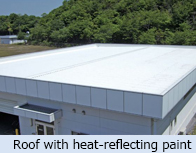
A variety of capital investments are carried out at our manufacturing sites to raise the energy efficiency of facilities and equipment. This includes introducing heat-reflecting paint for building surfaces to prevent temperature rises caused by the powerful rays of the sun. The paint, which was first applied to the Tsukuba Plant in 2012, has now been applied to the Ube Plant as well.
Creating a Low-Carbon Society by Introducing Energy-Saving Lighting and Using Renewable Energy
At our Works, we are committed to conserving electricity by changing to energy-saving lighting, using sensor lighting, and reducing lighting while maintaining the necessary brightness. We also use renewable energies (solar power generation, wind power generation, and geothermal heat.)
 LED lighting
LED lighting
 Geothermal heat
Geothermal heat
 Wind/solar power generation
Wind/solar power generation
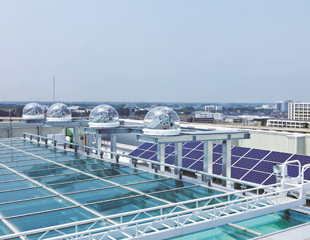 Automatic solar tracking lighting device and solar power generation
Automatic solar tracking lighting device and solar power generation
